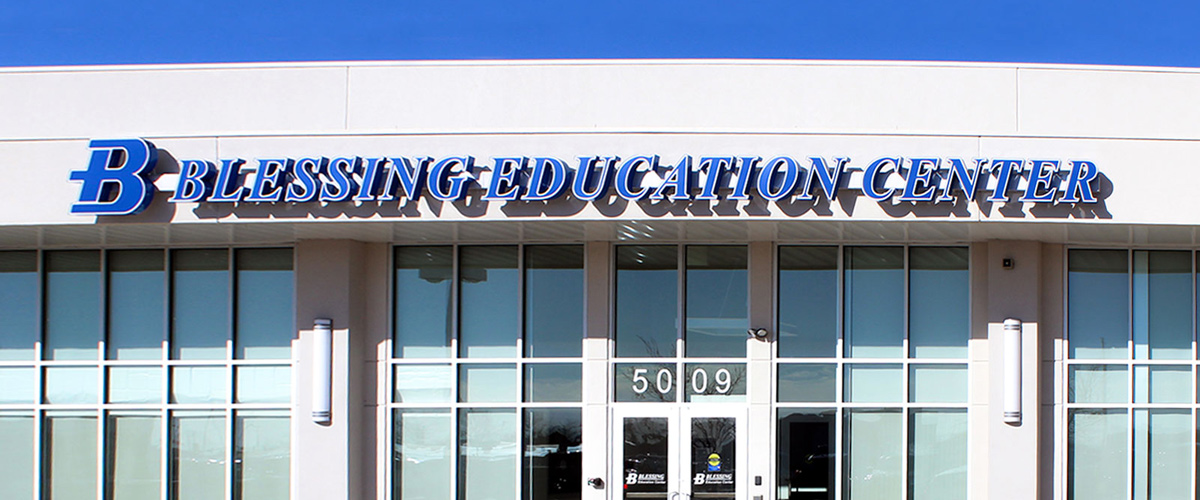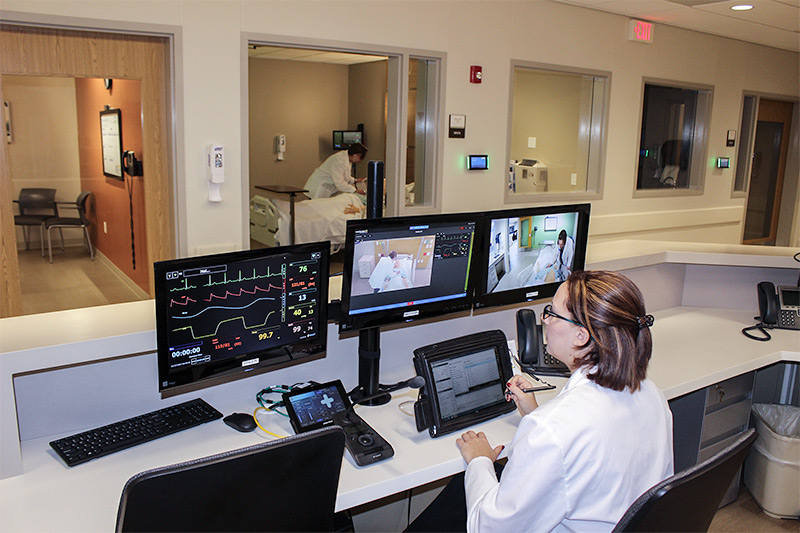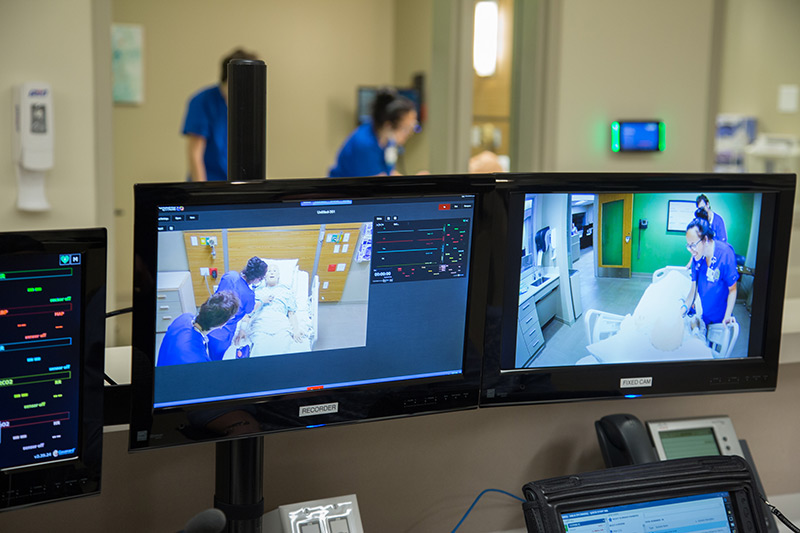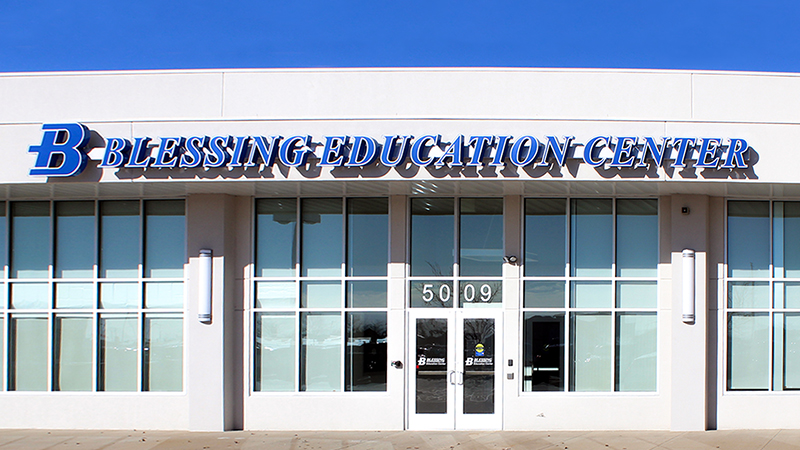
Case Study: Blessing Hospital
OmniStream Networked AV platform Stimulates Simulated Healthcare Learning
Download the Case Study PDFCritical nursing and health science programs at Blessing-Rieman College benefit from Atlona’s OmniStream™ AV over IP platform to eliminate older, maxed-out analog systems while providing fast switching speed and ensuring future AV systems growth.
Blessing Health System is a visible part of the fabric in the small Midwestern city of Quincy, Illinois. In addition to the 307-bed Blessing Hospital and the charitable, community-focused support system that comprises the Blessing Foundation, the growing healthcare organization offers a range of educational programs and training services at its own private college.
Situated close to Blessing Hospital, the Blessing-Rieman College of Nursing & Health Sciences has been offering these programs and services for more than 125 years. To accommodate its own growth, the college recently relocated to a building on 11th and Oak in downtown Quincy.


As often happens in these situations, the organization wanted to salvage some of its existing AV equipment, and integrate those components alongside new technologies that would better complement today’s more digitally-focused learning environments. Southwest Audio-Visual, a Missouri-based systems design and integration firm that also specializes in AV equipment sales, was hired to achieve this delicate balance in the new facility’s educational crown jewel: The Simulation Center.
IP Video Distribution: Moving from Switcher to Switch
The Simulation Center at Blessing-Rieman is a complete hospital unit with nine patient rooms and five control stations, and is where students are offered specialized instruction and a sophisticated learning environment to master clinical skills. This includes working with male, female and pediatric manikins programmed to mimic medical complications.
Even though the new site wasn’t quite a brand-new building, the Southwest AV team was handed a clean slate to do their integration work. “Since we were moving to an existing structure, the construction team hired by the college handled the complete teardown of existing infrastructure, leaving little behind but walls and the electrical systems,” said Dustin Willis, project manager at Southwest AV. “We came into a clean facility with a fresh set of system design plans. The main job was to merge audio systems from the previous location with a networked architecture for video, driven by Atlona’s OmniStream™ AV over IP platform.”
The college opted for an isolated network to support AV systems, chiefly to work around privacy laws and other restrictions associated with Blessing Hospital’s main network.
“We established a multicast-capable network leveraging off-the-shelf Cisco SG300-52MP managed switches to ensure that OmniStream could live and operate on the IT infrastructure, alongside internet and other data traffic,” said Willis.
The primary driver that took Southwest AV down the IP path started with, perhaps unusually, the switcher frame size. The previous analog AV infrastructure was limited to a 32×32 chassis that was long maxed out, and most digital fixed-frame systems offer the same capacity. It was clear that the new facility would be limited by a 32×32 infrastructure, as the college intends to add more rooms within the Simulation Center in the coming years.
The next natural option was an upgrade to a 64×64 fixed-frame system. While these were readily available, budget constraints removed this option from the table.


“The primary driver that took Southwest AV down the IP path started with, perhaps unusually, the switcher frame size… The next natural option was an upgrade to a 64×64 fixed-frame system. While these were readily available, budget constraints removed this option from the table. ”
– Dustin Willis, project manager at Southwest AV
“With a feasible IT infrastructure of network cabling and switches in place and plenty of bandwidth, we set our sights on the quickly evolving universe of AV over IP,” said Willis. “However, as an emerging approach to applying AV technology, particularly on the video side, we had our share of concerns. Would the system be reliable, and what trade-offs would there be in signal latency and overall quality? Our search eventually led us to OmniStream AV over IP to provide all switching and distribution needs over the network.”
The OmniStream many-to-any architecture proved flexible enough to fulfill the facility’s needs without the extra costs and unused capacity that the integration team would have been handed with a larger 64×64 frame.
Station to Station
“Would the system be reliable, and what trade-offs would there be in signal latency and overall quality? Our search eventually led us to OmniStream AV over IP to provide all switching and distribution needs over the network.”
– Willis
The control stations represent the central activity of the technical infrastructure. At these locations, instructors monitor two camera views and the vital signs of each manikin across three displays. Each patient room features a fixed camera at the head of the bed looking downward at the manikin, and a PTZ camera across the room. Based on a script of triggers, the instructor can initiate symptoms including elevated pulse and plummeting blood pressure. The student at the control station must diagnose and react to these changing medical conditions.
Using two-way audio connectivity, students in the patient room speak to the “patient”. Voice is captured over Shure® MX202WP/C ceiling microphones and transmitted to the nurse’s station over an IP-enabled Biamp® AudiaFLEX digital audio platform. Instructors listen to the diagnoses over headsets, and respond over the bi-directional IP audio link using Biamp pagingstations. The paging stations offer all-call and zoned paging, and simulation of large scale events such as a “code-blue” are also possible.
While the Biamp architecture provides IP transport of audio over CobraNet between the nine patient rooms, five control stations and OR simulation room, OmniStream paved the way for cleanly transitioning all video sources and destinations to the school’s dedicated IT network. The complete OmniStream installation includes 18 encoders (nine OMNI-111 single-channel and nine OMNI-112 dual-channel models) and 18 decoders (eleven OMNI-121 single-channel and seven OMNI-122 dual-channel decoders). With two inputs and two network connections, the dual-channel models offer the flexibility to reduce the stream size to preserve network bandwidth, yet retain 1080p quality.
In each of the nine patient rooms, the OMNI-112 dual-channel encoders natively accept the HDMI feeds from the cameras, and distribute them to generic computers over USB extenders. In most rooms, the computers output the video content into the HDMI input of an OMNI-111 single-channel encoder, which places the video on the managed switch. That content is then moved to the OMNI-121 and OMNI-122 decoders, which output the HDMI signals to 19-inch generic video monitors.
At each control station, instructors can manipulate PTZ camera movements, such as zooming into an IV pump or the face of a manikin. A separate OR simulation room includes two multiple PTZ cameras for this purpose, and excludes the fixed camera used in the general patient rooms.
Seamless Networking For Audio and Video
OmniStream eliminated the latency concerns of point-to-point transmission of 1080p video between patient rooms and control stations immediately on deployment. (4K/UHD sources are supported on OmniStream and remain in consideration; the current cameras and recorders at Blessing top out at 1080p) With sub-frame latency, video moves seamlessly over the network even as switches re-synchronize to accommodate new video sources.
“(There is) virtually no delay upon source switching compared to other IP-based HDMI switching systems that took between five and ten seconds to re-lock signals upon switching.”
– Willis
“That speed allows us to mirror the analog functionality of the old system that users were accustomed to enjoying – virtually no delay upon source switching,” said Willis. “This is compared to other IP-based HDMI switching systems that took between five and ten seconds to re-lock signals upon switching. Instead, students see the camera angles in near real-time, without blockiness or degradation in resolution; and no reactive delay in mouse clicks and keyboard strokes as students work with video sources.”
All audio and video sessions are recorded into Sonic Foundry’s MediaSite RL HD digital recording systems. This system includes multiple inputs to ingest content, which then automatically uploads to a cloud server. This approach ensures that instructors and students to review educational content at a later date.
“The technical infrastructure in place today will accommodate growth (and when required, signal redundancy) without issue as new rooms are added, and more components are needed,” said Willis. Two additional patient rooms have been carved out that will be added to the network at a later date, and expansion channels exist in OmniStream to simplify video scalability of the network.
“OmniStream itself can grow until switch capacity is reached, which will take many years to fill,” said Willis. “In fact, as both cameras in each patient room combine into an OMNI-112 Dual-channel encoder to utilize a single network drop, the overall switch count was minimized, and there are extra wires for expandability. This architecture required less network infrastructure and half the hardware, and ensures that all transmitting and receiving devices can perform double duty over a single network connection – an ideal blueprint to build on as the facility grows moving forward.”
| PRODUCTS FEATURED | |
| Model | Description |
| AT-OMNI-111 | Networked AV encoder for one HDMI source up to 4K/UHD, plus embedded audio and RS-232 control |
| AT-OMNI-112 | Networked AV encoder with two independent channels of encoding for two HDMI sources up to 4K/UHD, plus embedded audio and RS-232 control |
| AT-OMNI-121 | Networked AV decoder for an OmniStream-encoded video stream up to 4K/UHD, as well as embedded audio and RS-232 control |
| AT-OMNI-122 | Networked AV decoder with two independent channels of decoding for two OmniStream-encoded video streams up to 4K/UHD |







